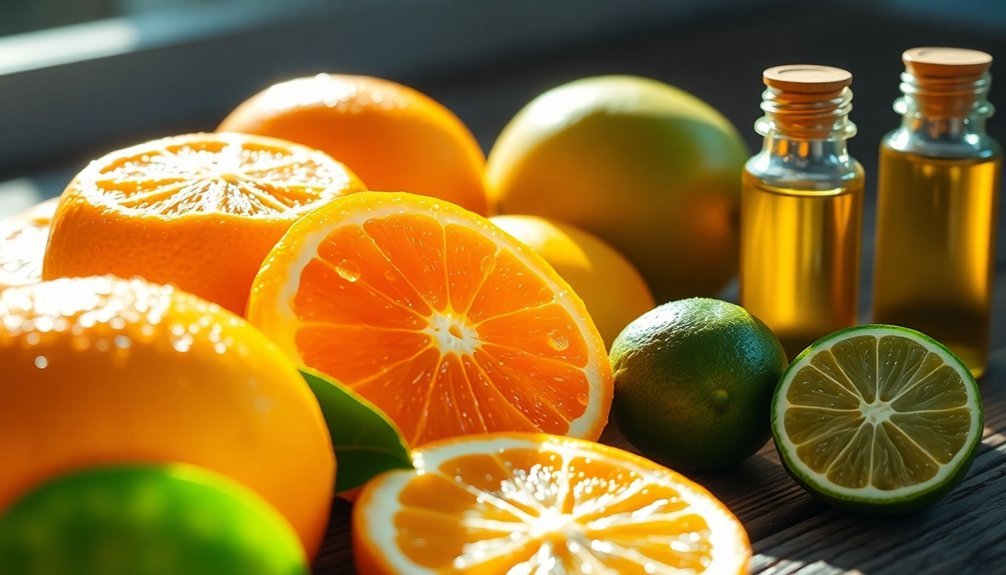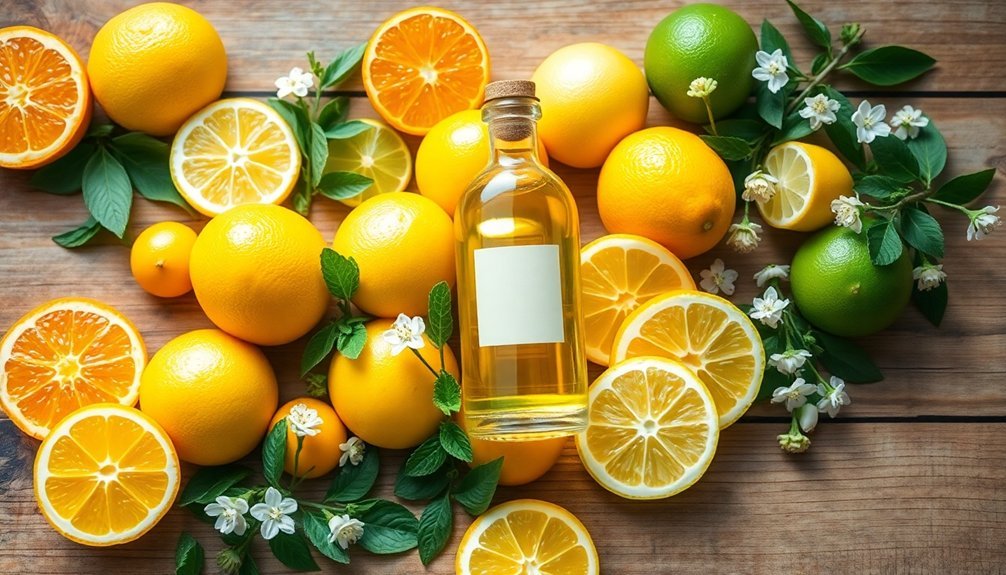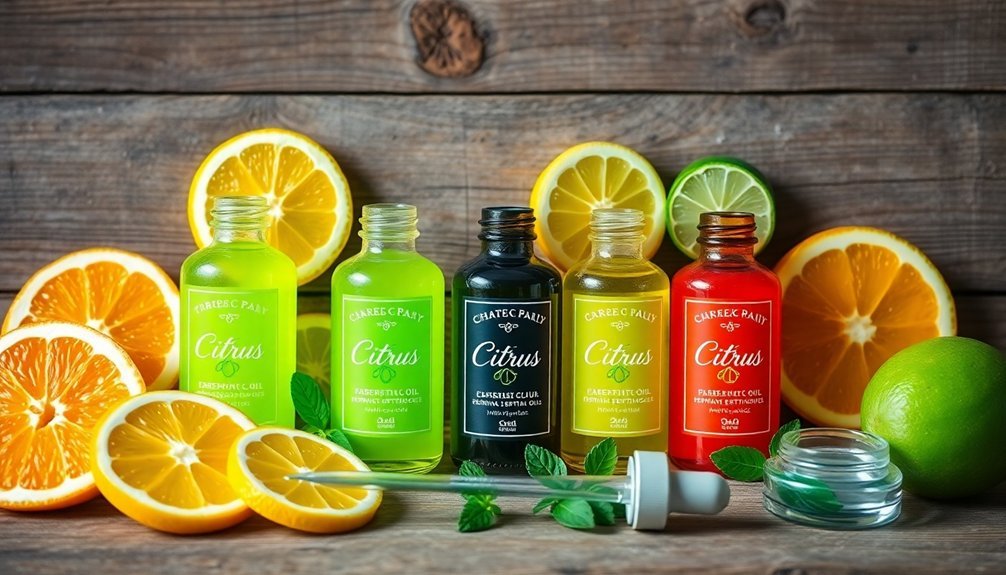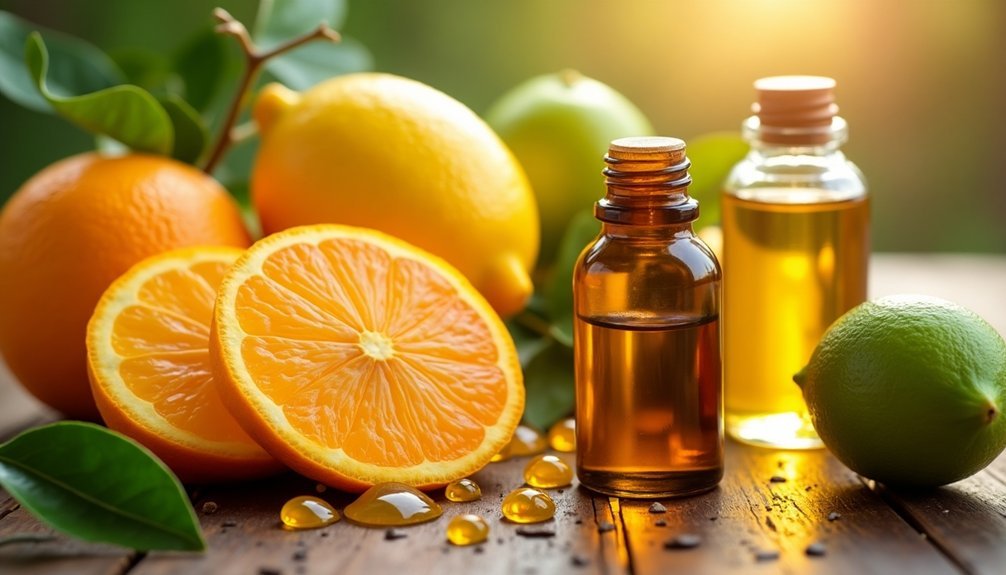Create perfect citrus essential oil blends by combining vibrant top notes like lemon, orange, and bergamot with floral middle notes and woody base notes. You'll want to follow the 30/50/20 rule for balancing top, middle, and base notes while maintaining a 2% dilution rate for skin safety. Start with simple combinations like citrus-mint (3 drops spearmint with 2 drops each of your chosen citrus oils) for an invigorating scent. Discover how complementary notes like lavender and cedarwood can transform your blends into complex, lasting fragrances.
Understanding Citrus Essential Oil Properties for Perfumes

Whether you're crafting your own perfume or selecting a signature scent, understanding citrus essential oils' properties is essential for success in perfumery. These oils, rich in limonene, serve as vibrant top notes that provide your fragrance's initial burst of freshness while offering therapeutic benefits.
You'll find citrus oils exceptionally versatile, as they blend harmoniously with floral and woody notes to create complex, elegant compositions. Bergamot orange oil adds an exquisite sweet-tangy dimension to fragrances. While they're known for their bright, zesty characteristics, they also contribute to the perfume's emotional impact through their mood-enhancing properties.
The main challenge you'll face is balancing their intense initial impact with longevity, as citrus notes are highly volatile. For the best results, you'll want to take into account how these oils interact with other fragrance families to achieve your desired olfactory experience.
Essential Ratios for Balanced Citrus Blends
You'll find that mastering citrus essential oil ratios starts with basic combinations like citrus-mint blends, which follow the standard 2% dilution rule of 4 drops per 2 teaspoons of carrier oil.
For seasonal citrus recipes, you can create uplifting blends by combining different citrus oils with complementary scents like bergamot and lavender using the 30/50/20 rule for top, middle, and base notes. Essential oils should always be properly diluted first to minimize the risk of skin sensitivity and irritation.
Whether you're new to blending or experienced, reference charts show you exactly how many drops to use for different applications, from a gentle 0.5% dilution (1 drop per 2 teaspoons carrier oil) to stronger 3% blends for massage oils (6 drops per 2 teaspoons carrier oil).
Blending Citrus With Mint
Ever wondered how to create the perfect balance between zesty citrus and cool mint essential oils?
When blending these scents, keep in mind that light molecules evaporate quickly which means your citrus-mint blend will offer an immediate but short-lasting burst of freshness.
You'll find that combining these top notes creates an invigorating blend that's perfect for energizing your space. Since both citrus and mint oils are top notes, you'll want to add middle and base notes for a well-rounded fragrance using the 30-50-20 rule.
- Try the Citrus Mint Blend: Mix 3 drops spearmint with 2 drops each of lime, grapefruit, lemon, peppermint, and orange.
- Create a Simple Citrus-Mint Mix by combining equal parts lemon, lime, and peppermint.
- Add depth with middle notes like geranium (5 drops) to every 3 drops of your citrus-mint mixture.
- Remember to maintain a 1-3% dilution rate for safe use, and avoid sun exposure when using citrus oils.
Seasonal Citrus Mix Recipes
Creating balanced citrus essential oil blends requires careful attention to seasonal variations and proper ratios.
For spring, you'll find success with light combinations like the Freshen Up blend, which mixes equal parts thyme, rosemary, grapefruit, and eucalyptus oils.
Summer calls for higher citrus concentrations, as seen in the Lemon and Mint blend where citrus oils comprise 87.5% of the mixture.
Fall blends incorporate warmer notes, with recipes like the Cozy Vibes blend using bergamot and lemon balanced with elemi and wintergreen.
Winter formulations focus on grounding scents, combining citrus with woody notes like cedarwood.
Each season's ratios are carefully calculated to achieve the perfect balance – summer blends typically use 30-50% citrus oils, while winter blends reduce this to 20-30% to accommodate heavier base notes.
Ratio Charts For Beginners
Three fundamental ratios form the backbone of successful citrus essential oil blending. When you're starting out, following the 30/50/20 rule will help you create balanced fragrances that smell amazing.
Begin with 30% top notes like lemon or grapefruit, add 50% middle notes such as lavender or rosemary, and finish with 20% base notes like cedarwood or frankincense.
- For a 10-drop blend: Use 3 drops citrus (top), 5 drops floral/herbal (middle), 2 drops woody (base)
- For a 20-drop blend: Use 6 drops citrus, 10 drops floral/herbal, 4 drops woody
- For a 30-drop blend: Use 9 drops citrus, 15 drops floral/herbal, 6 drops woody
- For a 40-drop blend: Use 12 drops citrus, 20 drops floral/herbal, 8 drops woody
Creating Your Signature Citrus Fragrance
Have you dreamed of wearing a citrus fragrance that's uniquely yours? Creating your signature scent starts with selecting quality citrus oils and understanding how to layer them effectively. You'll need to combine your chosen oils using the classic perfumery structure of top, middle, and base notes.
| Layer | Suggested Oils |
|---|---|
| Top | Lemon, Orange, Bergamot |
| Middle | Grapefruit, Mandarin |
| Base | Sandalwood, Cedarwood |
| Carrier | Jojoba, Sweet Almond |
| Enhancers | Patchouli, Light Florals |
Start by testing different combinations on your skin, and don't rush the process. Let your blends mature for several days, then adjust the ratios until you've achieved your perfect scent. Record your successful formulas, and consider creating seasonal variations of your signature fragrance for year-round wear.
Top Citrus Combinations for Lasting Scents

You'll discover that citrus oils pair exceptionally well with mint varieties, creating vibrant and long-lasting fragrances that energize your senses.
The bright acidity of lemon blends perfectly with the cooling sensation of mint, offering a rejuvenating combination that works beautifully in both personal and home fragrances.
This dynamic duo provides an invigorating balance between sweet and tart notes, making it an excellent choice for morning routines or midday pick-me-ups.
Combining Citrus With Mint
A burst of invigorating freshness awaits when you combine citrus and mint essential oils.
These dynamic blends create uplifting aromas that'll energize your senses and transform any space into a revitalizing sanctuary.
You'll find that spearmint pairs beautifully with various citrus oils, while peppermint adds an extra cooling dimension to your blend.
- Mix orange and spearmint in your diffuser for a mood-lifting atmosphere
- Combine lime and spearmint for a sharp, clean fragrance
- Blend grapefruit and spearmint to boost mental clarity
- Pair bergamot and spearmint for a sophisticated, rejuvenating scent
Remember to store your oils properly and follow safety guidelines, especially regarding photosensitivity.
You can use these blends in diffusers, room sprays, or diluted with carrier oils for massage – just avoid sun exposure after topical application.
Balancing Sweet and Tart
Creating perfectly balanced citrus blends requires understanding the interplay between sweet and tart notes.
You'll want to start with core oils like sweet orange and mandarin to establish a gentle base, then layer in more intense oils like lemon or grapefruit for brightness.
Bergamot serves as an excellent bridge between sweet and bitter elements.
To make your blends last longer, you'll need to incorporate middle and base notes.
Try adding lemongrass to extend the citrus profile, or vanilla to provide warmth and staying power.
For an energizing blend, combine sweet orange, lime, and mandarin.
If you're seeking a more complex aroma, mix bergamot with blood orange and grapefruit, then anchor it with a resin like frankincense.
Remember to store your creations in a cool, dark place.
Enhancing Your Blends With Complementary Notes
Successful citrus essential oil blends come alive when paired with complementary notes that enhance their bright, energetic qualities.
You'll find that combining different aromatic families creates depth and complexity in your blends, making them more sophisticated and enjoyable.
- Add floral notes like lavender, ylang ylang, or geranium to soften citrus oils' zesty character while creating a soothing, balanced aroma.
- Incorporate spicy elements such as cinnamon, black pepper, or cardamom to add warmth and invigoration to your citrus blends.
- Mix in woody oils like cedarwood, patchouli, or rosewood to provide grounding and depth.
- Include minty or herbal notes from peppermint, eucalyptus, or rosemary for a cooling, invigorating effect that complements citrus's natural brightness.
Best Practices for Storage and Application

Proper storage and handling of citrus essential oils can greatly extend their shelf life and maintain their therapeutic properties. Since citrus oils oxidize faster than other essential oils, you'll need to take extra precautions to preserve their quality.
Store your citrus blends in dark amber glass bottles at temperatures between 5-30°C, away from sunlight and humidity. You'll want to keep them in a cool, dark place or refrigerator, separate from food items.
Always verify caps are tightly sealed and store bottles upright to protect the droppers. Since citrus oils typically last only 1-2 years under ideal conditions, it's smart to use smaller bottles and track purchase dates.
Check your oils regularly for changes in smell or appearance, and discard them if you notice any deterioration.
Frequently Asked Questions
Can Pregnant Women Safely Use Citrus Essential Oil Blends?
You can use some citrus oils during pregnancy, but don't start until after your first trimester. Always dilute them properly, consult your healthcare provider first, and stick to gentle options like lemon and sweet orange.
How Long Do Citrus Essential Oil Blends Typically Maintain Their Fragrance?
You'll typically notice your citrus essential oil blends maintain their fragrance for 2-4 hours on skin. However, when stored properly in dark bottles, they'll keep their potency for 1-2 years in the bottle.
Will Citrus Essential Oils Stain My Clothes or Furniture?
Yes, citrus essential oils can stain your clothes and furniture, especially if undiluted. You'll want to dilute them with carrier oils and avoid direct contact with fabrics to prevent yellow staining.
Can Citrus Essential Oil Blends Repel Insects Naturally?
Yes, you'll find citrus essential oils like citronella and lemongrass are effective natural insect repellents. You can diffuse them or create diluted sprays to keep mosquitoes and other bothersome insects away from your space.
Are Citrus Essential Oil Blends Safe to Use Around Pets?
No, you shouldn't use citrus essential oils around pets. They're toxic and can cause serious health issues, including organ damage. Always consult your veterinarian before using any essential oils in homes with pets.
In Summary
Now you're ready to create your own signature citrus essential oil blends. Remember to start with small batches, keep your oils properly stored in dark glass bottles, and don't be afraid to experiment with different combinations. You'll find that citrus oils blend beautifully with florals, herbs, and woods. Trust your nose, take notes on what works, and you'll soon master the art of crafting fresh, uplifting fragrances.
References
- https://healingscents.com/cirus-fresh-essential-oil-blend.html
- https://www.youngliving.com/blog/citrus-fresh-essential-oil-uses-and-benefits/
- https://www.essentialoils.life/citrus-fresh-essential-oil-blend/
- https://vitruvi.com/products/boost-essential-oil-blend
- https://getsunmed.com/blogs/blog/benefits-of-citrus-essential-oils
- https://anthonymarmin.com/the-perfume-blog/citrus-in-perfumery
- https://www.carthusia.it/en/citrus-scents/
- https://gyalabs.com/blogs/essential-oils/citrus-essential-oil-blends
- https://www.alphaaromatics.com/blog/citrus-perfumes/
- https://www.aerowest.com/using-citrus-fragrances-to-increase-productivity-at-work/





Leave a Reply